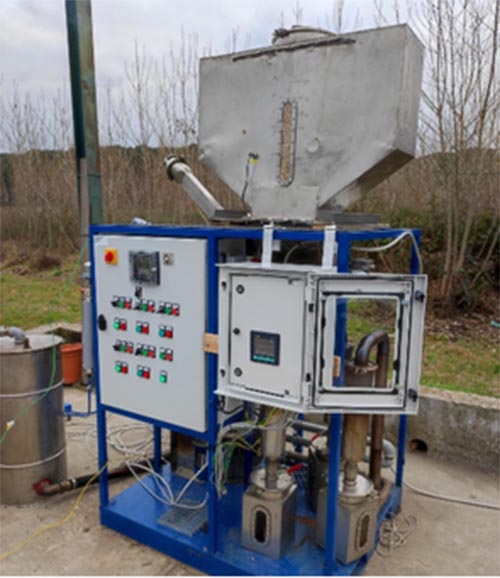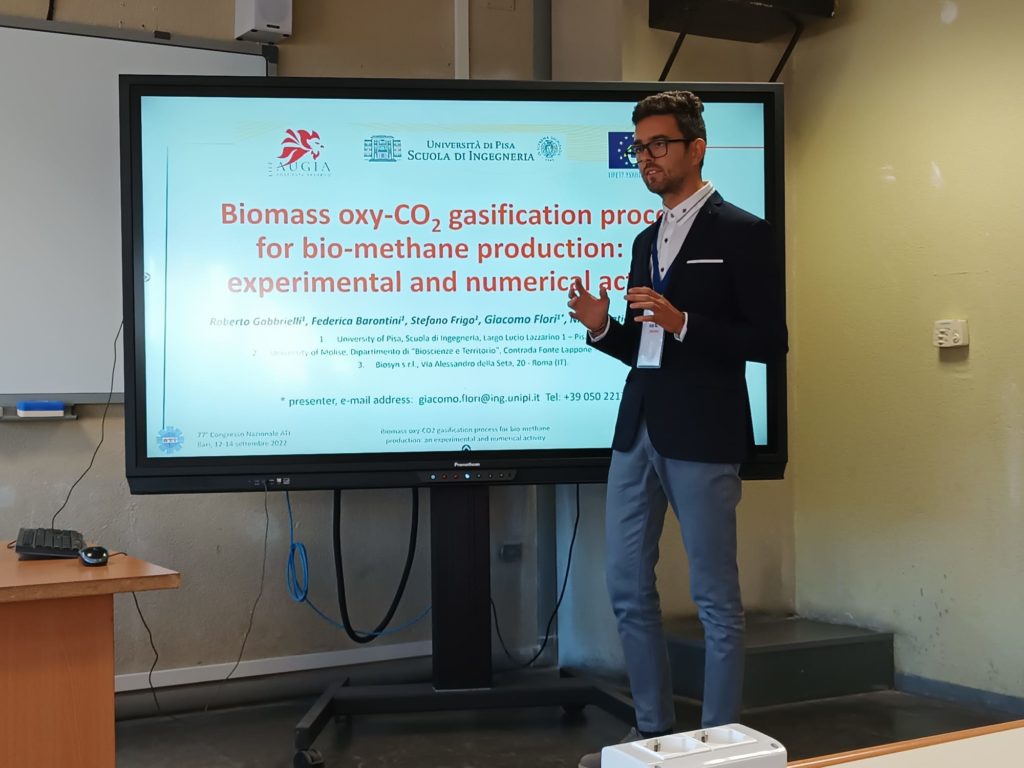77th ATI National Congress in Bari on the 12-14th of September 2022
Owing to the delay accumulated in the first months of the AUGIA project, the action B3 “Operation of the oxy-gasification plant”, whose start was initially forecasted in September 2021, is not started yet. In the meantime, the UNIPI research team decided to start a preliminary experimental activity to analyse the effectiveness of the oxy-gasification approach, utilising a small-scale, fixed bed (downdraft) gasification plant, already located in the research area of the University of Pisa. This small gasifier, that has a thermal power of roughly 1/10 of the AUGIA gasifier (the small gasifier thermal power is roughly 100 kW), can be in any case considered representative of the overall process (the two gasifiers are of the same type, i.e. fixed bed-downdraft). Therefore, information and data collected with the small gasifier can be effectively utilised to better understand the oxy-gasification process and the reliability of the associated numerical model, already developed and implemented in Aspen Plus® environment (see deliverables D.A1.2, D.A1.3 and D.A1.4).
The small gasification plant, shown in Figure 1 and already exploited for previous research activities using only biomass and air as gasifying agent, was properly modified for the AUGIA project needs. In particular, the conventional air-gasification approach has been replaced by oxy-CO2 gasification technology. The decision to start with oxy-CO2, instead of oxy-steam as planned in the AUGIA project, is due to the fact that the availability of CO2 was already present at the UNIPI experimental area. The steam use requires the presence of a small steam electrical boiler and a proper piping system, which will be adopted in a second time. It is noteworthy to recall that carbon dioxide and steam are utilized as gasifying agents with oxygen, in order to mitigate its reactivity, which can lead to excessive reaction temperatures; at the same time, they also take part to the gasification process, promoting the main reactions versus the secondary ones.

Figure 1. The experimental gasifier.
The preliminary experimental activities, which was carried out at the laboratories of the University of Pisa, have been managed with the operative support of qualified personnel from UniMol and BioSyn srl, partners of AUGIA project; it demonstrated the feasibility of the O2-CO2 biomass gasification approach and satisfying values of the gasification process have been obtained, with a maximum CGE of about 70% and a syngas LHV of roughly 8 MJ/Nm3. Useful information was also acquired concerning the correct procedures for the oxy-gasification process start up and normal running (see the report on the action B31 for more information).
The gasifier simulation model, which was tuned using some experimental data, showed that it is possible to get high performances when the CO2 amount is lowered with the drawback of increasing the reaction temperature. So, the CO2 shall be reduced at most in accordance with the temperature limits due to the structural integrity of the equipment.
In accordance with the numerical results, it seems that the optimal condition can be obtained using an intermediate amount of oxygen (ER ≈ 0.32%), in order to have a good compromise between the temperature of the syngas and the efficiency of the gasification process; in fact, the performances decrease with high values of ER, where the oxidation reactions take place largely. Moreover, the value of the CO2/Biomass mass flow ratio should be around 0.75, ensuring a compromise between the conversion of biomass to syngas and the temperatures of the syngas itself.
The results of this preliminary experimental activity carried out using the small gasifier and focused on the oxy-CO2 gasification approach are described in detail in a scientific paper entitled “Biomass oxy-CO2 gasification process for bio-methane production: an experimental and numerical activity”, which was presented at the 77th ATI National Congress in Bari on the 12-14th of September 2022. These activities can be included in action D1.2 “Technical dissemination activities” of project AUGIA, because can contribute to raise the global interest on this scientific research area.
In the next future the experimental campaign focused on oxy-steam gasification technology will start, as the main topic of the AUGIA project, but also mixtures of them (O2/steam/CO2) will be analysed.


